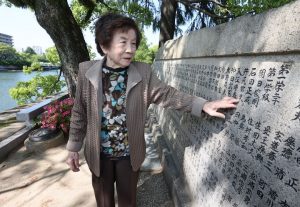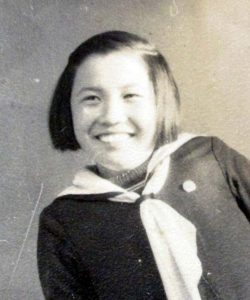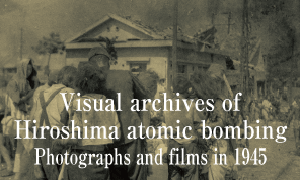Survivors’ Stories: Mineko Nakagawa, 95, Minami Ward, Hiroshima City―Witnessing younger brother’s tragic final moments
Jun. 16, 2025
She folds paper cranes, hoping war will never ever be waged again
by Jumpei Fujimura, Staff Writer
Mineko Nakagawa, 95, was 15 years old at the time of the atomic bombing. Amid the chaos, she found her younger brother suffering from severe burns and witnessed his final moments. She has continued to console the spirit of her brother, who died at the age of 12, as well as children of his generation who also died tragically in the A-bombing. Today, she expresses her wish for peace by handing folded paper cranes to visitors in Hiroshima.
At that time, Ms. Nakagawa was a third-year student at Hiroshima First Municipal Girls’ High School (First Girls’ School; now Funairi High School). On the morning of August 6, 1945, she had a day off from the munitions factory where she had been mobilized, and was sweeping in front of her house in Funairi-honmachi (now part of Naka Ward), about 1.5 kilometers from the hypocenter.
She has no memory of the flash or sound when the atomic bomb exploded. When she came to, she had been blown about 10 meters away, and everything around her was pitch dark. As it had been morning, she pinched herself to make sure it was not a dream. Before long, it gradually grew lighter, like the break of dawn.
When she looked down, she saw that the left side of her body was covered in blood, injured by roof tiles hurled through the air by the blast. She fled with her grandmother and her mother, who had been at home, to a fig field in the Eba area (now part of Naka Ward). They also miraculously reunited with her sister, who was three years older.
They worried about her younger brother, Norio Ijiri, a first-year student at Hiroshima Second Prefectural Junior High School (now Kanon High School). He had been mobilized to help demolish buildings at the east end of Shin-Ohashi Bridge (now West Peace Bridge).
Ms. Nakagawa and her elder sister went there and found countless bodies floating in the river. Many people with severe burns were sitting close together on the stone steps leading down to the water. She said, “Those who could no longer move slid down the stone steps.”
On August 7, they finally found Norio. They saw a roof tile near the injured with the words “Second Middle School, Ijiri” and nearby, people lay with their heads resting on the streetcar tracks. Ms. Nakagawa said, “My sister and I called out to him, and he answered, ‘Sister.’” They had walked past the same place seven times before finding him. His body’s burns were terrible and he asked them to cut away the strips of skin that hung from his body.
Norio said he had been rescued from under the rubble immediately after the A-bombing by a stranger, who said, “When you grow up, beat America.” After that, his delirium increased, and he only spoke of water, saying things like, “Let’s go swimming in the river,” and “Let’s get in the bath and swim.”
Shortly before his death, he spoke to each member of his family and passed away on the morning of August 9. Ms. Nakagawa said, “I’m glad I was able to speak with him in his final moments,” and she still remembers his face whenever she sees a child whose head shape resembles his.”
After the war, when First Girls’ School reopened, one of Ms. Nakagawa’s classmates who had seemed fine did not come to school the next day and passed away. Unsure as to the effects of radiation, Ms. Nakagawa lived with constant worry about her health.
Until recently, she had shared her experiences of the A-bombing only with her family. However, three years ago, her eldest son, Toshiaki, 74, began to serve as what is called an “A-bomb Legacy Successor” on behalf of another A-bomb survivor, and she began folding paper cranes to distribute at his talks. She has folded more than 3,000 paper cranes, praying fervently that war would never ever be waged again.
She attended the memorial services for Second Middle School and First Girls’ School almost every year, though it became difficult for her after she turned 90. Still, she hopes the tragedies of both schools will be passed on forever, saying, “I want my younger schoolmates to do their best.”
(Originally published on June 16, 2025)









